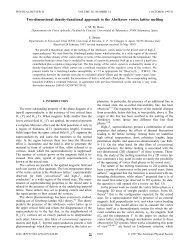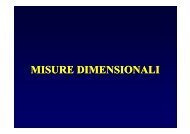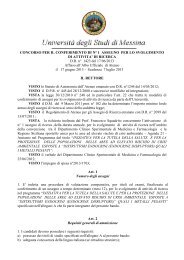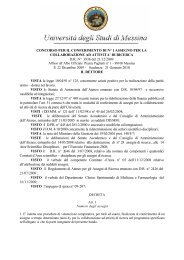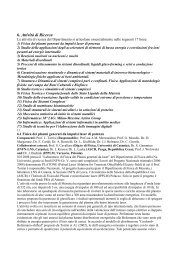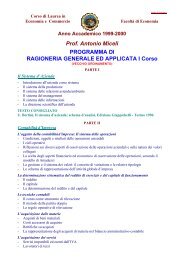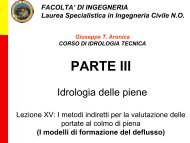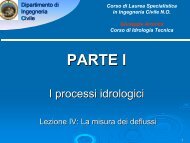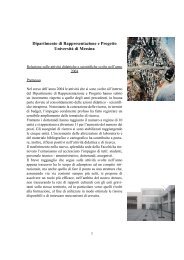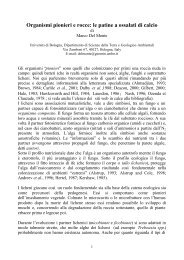PROGRAMME AND ABSTRACTS - Università degli Studi di Messina
PROGRAMME AND ABSTRACTS - Università degli Studi di Messina
PROGRAMME AND ABSTRACTS - Università degli Studi di Messina
Create successful ePaper yourself
Turn your PDF publications into a flip-book with our unique Google optimized e-Paper software.
Hans Thomas Hakl, independent scholar, Austria<br />
Julius Evola’s Relations with Women<br />
Male and female are two transcendent categories for Evola which accor<strong>di</strong>ng to Aristotle can be<br />
characterized as “active” and “passive”. A heavy influence exerted by Otto Weininger’s work<br />
Sex and Character strengthened this attitude of his. And when he was 26 he wrote a<br />
provocative essay titled “Woman as object”. At the same time he dressed and behaved as a<br />
dandy giving way to rumours that he was a homosexual although no proof has ever been<br />
produced for this allegation. On the contrary Evola was a known womanizer nicknamed the<br />
“spider” because of all the women en<strong>di</strong>ng up in his “net”. Although he never spoke about it<br />
two famous women had a love affair with him. The first was Sibilla Aleramo (Rina Faccio) an<br />
early feminist, communist and writer, who was friends with the likes of Maxim Gorki, Luigi<br />
Pirandello, August Ro<strong>di</strong>n or James Joyce. She wrote about her love affair with Evola in a<br />
novel. The second famous woman with whom he most probably had an affair was Maria de<br />
Naglowska, a Russian poetess and founder of a satanic sex cult. There are however two further<br />
la<strong>di</strong>es whom I could still interview in the eighties of the last century who talked to me about<br />
their relations with Evola. One was a very successful business woman in Hannover, who freely<br />
admitted to have been in love with him. She also had helped him with translations from<br />
German. The second lady came from an old noble family in Germany and was the first wife of<br />
Ludwig Fer<strong>di</strong>nand Clauss, the renowned German expert on psychological racial traits, greatly<br />
admired by Evola. She told me about Evola’s strong presence during the three or four visits he<br />
paid to her husband. Quite well known are also his cynical remarks about women in general as<br />
they appear in letters or in conversations, one example being the conversation he had in Roma<br />
with the Zen expert Karlfried Graf Dürckheim. Although Evola has the reputation of being a<br />
misogynist this probably was not the case. Otherwise, how could we explain, that he asked<br />
two women to execute his last will.<br />
Tue 15 th , 11.00, Classroom 5<br />
Olav Hammer, University of Southern Denmark, Odense, Denmark<br />
Modern Jesus Legends and the Modalities of Religious Innovation<br />
Religious innovations, and an ensuing religious plurality, regularly arise when elements of<br />
religious <strong>di</strong>scourses, practices and social formations migrate across the porous and often quite<br />
arbitrary boundaries between tra<strong>di</strong>tionally defined social arenas and religious tra<strong>di</strong>tions. This<br />
tendency toward innovation and plurality is counteracted by intense <strong>di</strong>sciplining by those who<br />
wish to construct a religious monoculture, erect boundaries between “mainstream” and<br />
“alternative”, and legitimate the former at the expense of the latter. Vestiges of this <strong>di</strong>sciplining<br />
process influence even prevalent theorizing on the development of “alternative” religious<br />
developments. Well-known sociological theories, e.g. Colin Campbell’s concept of the cultic<br />
milieu, presuppose that there is a dominant, nearly monolithic mainstream culture, in<br />
opposition to an underground of <strong>di</strong>vergent and deviant innovations. Departing from a case<br />
study, the development of a number of modern “alternative” Jesus legends from Blavatsky to<br />
Dan Brown, this paper investigates how an anthropologically informed concept of culture and<br />
religion as a profuse repertoire of <strong>di</strong>scourses and practices might elucidate a number of<br />
mechanisms of religious innovation, plurality, hybri<strong>di</strong>ty, and <strong>di</strong>sciplining.<br />
93<br />
Tue 15 th , 16.20, Classroom 13




